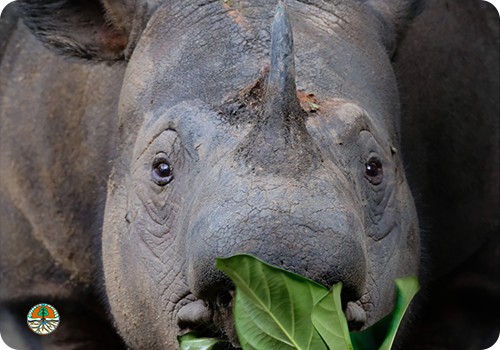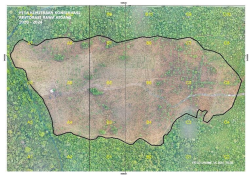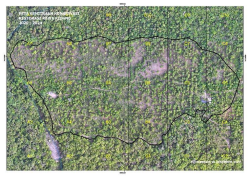REVIVING RAINFORESTS: A GOURMET BUFFET FOR RHINOS IN THE MAKING

This blog was written by IRF partner, INDONESIAN RHINO INITIATIVE (IRI)
Indonesia’s Way Kambas National Park (WKNP) is home to some of the world’s most unique and threatened mammal species, including Sumatran elephants, tigers and rhinos. The Indonesian Rhino Initiative (IRI) is an organization whose mission is to protect Indonesian rhinos, their habitats and biodiversity and work with the local community to use natural resources sustainably. Since 2020, IRF has supported IRI in their efforts to protect the Sumatran rhino and their habitat through restoration efforts in WKNP, while engaging the local community to restore degraded habitat.

The Sumatran rhino is a browser, a herbivore that feeds on leaves or fruits of plants such as shrubs. Sumatran rhinos consume roughly 10% of their body weight per day. The average weight of an adult Sumatran rhino is 600-800 kg (1300-1800 lbs), which means they eat around 60-80 kg (130 -180 lbs) per day. At the Sumatran Rhino Sanctuary (SRS), each rhino lives in a 10 hectare semi-wild paddock allowing them daily activity and browsing in the forest. However, while 10 hectares is a generous enclosure size, it is not large enough for a Sumatran rhino to reach their necessary daily feeding rates by browsing the available flora in their paddocks.
The Way Kambas Restoration Program
With 10 Sumatran rhinos living at the SRS, 3 more than just two years ago, the amount of food and plants needed daily is increasing. This is certainly a “good problem!” The SRS needs additional food sources every day to achieve the feeding rates for each rhino. In the past, the SRS management team purchased browse from the local community and also sent food collectors to prune trees and shrubs surrounding Way Kambas NP. But that was still not quite enough to keep up with the demand of 10 hungry and growing Sumatran rhinos.
The Way Kambas restoration program is one solution that the SRS is implementing to obtain additional browse for the SRS. Rawa Kidang restoration site, which is a restoration program in Way Kambas National Park (WKNP) supported by IRF in collaboration with WKNP and local farmers, was a dominant grazing area due to forest fire and human encroachment. Forest fires create grasslands, however these grasslands do not provide a suitable habitat for a lot of species who used to live in the area and they also pose a threat for quick spreading wildfires which slows down the natural forest regeneration process. Rawa Kidang restoration site has since been rehabilitated by planting rhino food trees and shrubbery, providing excellent habitat for wildlife.



This restoration program not only aims to restore the habitat that is a refuge for wild animals in WKNP but also to be an alternative food source for Sumatran rhinos living at the Sumatran Rhino Sanctuary.
Involving the Local Community
Initially, the restoration which began at the end of 2020, was only grassland and land that frequently experienced fires, but after being managed and involving the local community under the Rahayu Jaya Forest Farmers Group (KTH Rahayu Jaya), this part of Way Kambas National Park has no more fire incidents. At the end of November 2023, we were able to contribute some food plants to Sumatran rhinos at the Sumatran Rhino Sanctuary.
Involving the local community to help plant Sumatran rhino food plants at the restoration site Rawa Kidang not only helps people feel more connected to and support Sumatran rhino conservation but is also beneficial to them since this part of Way Kambas National Park, which used to experience frequent fires, has not experienced any more fire incidents. On the other hand, supporting restoration to support SRS in achieving feeding rates of Sumatran rhinos at the SRS also makes a great contribution. As a result, the restoration program can show the connection and real impact on the solving of the problem to get more food plants that are important for rhinos at the SRS. By engaging community based conservation initiatives to reduce disturbance, and encouraging sustainable land use practices, as well as support from donors, we can ensure the hope of providing food for rhinos and supporting their long-term survival.
